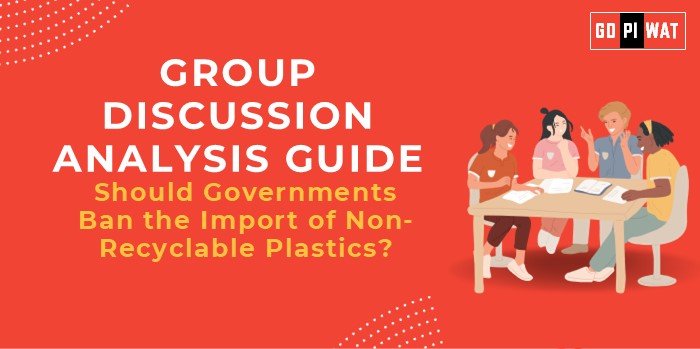📋 Group Discussion Analysis Guide: Should Governments Ban the Import of Non-Recyclable Plastics?
🌍 Introduction to the Topic
Opening Context: “With over 380 million tons of plastic produced globally each year, the non-recyclable fraction poses an escalating environmental crisis.”
Topic Background: The import of non-recyclable plastics has been a contentious issue due to their significant contribution to pollution and landfill overflow. International agreements like the Basel Convention aim to regulate transboundary movements of hazardous waste, but enforcement remains uneven.
📊 Quick Facts and Key Statistics
- ♻️ Global Plastic Waste: 9% of plastic waste is recycled globally (UNEP, 2023).
- 🇮🇳 India’s Plastic Import: India imported 15,000 tons of plastic scrap in 2023, of which 40% was non-recyclable (MoEFCC).
- 🌊 Marine Pollution Impact: 80% of ocean plastics originate from land-based sources, with imports contributing indirectly.
- 💰 Economic Cost: Non-recyclable plastics add $13 billion annually to marine ecosystem damages.
🌐 Stakeholders and Their Roles
- Governments: Policymakers imposing import bans and managing waste infrastructure.
- Private Sector: Manufacturers adopting sustainable materials or recycling technologies.
- Environmental NGOs: Advocating for bans and promoting public awareness.
- Global Bodies: The UN and Basel Convention Secretariat monitoring compliance and guidelines.
✅ Achievements and Challenges
🏆 Achievements
- 🌱 India banned single-use plastics in 2022, reducing local waste generation.
- 🇪🇺 The EU’s Circular Economy Action Plan has cut non-recyclable imports by 25%.
⚠️ Challenges
- 🏗️ Waste Management Deficit: Limited infrastructure for even recyclable plastics.
- 💸 Economic Backlash: Small manufacturers depend on imported low-cost plastics.
Global Comparisons: Success: South Korea recycles 54% of its plastic waste. Struggle: The US still exports 157,000 tons of non-recyclable plastic annually.
Case Study: India’s Maharashtra state diverted 5,000 tons of plastic waste into road construction projects.
📚 Structured Arguments for Discussion
- Supporting Stance: “Banning imports of non-recyclable plastics aligns with global sustainability goals and mitigates environmental damage.”
- Opposing Stance: “Such bans might disrupt industries reliant on low-cost plastics, increasing production costs.”
- Balanced Perspective: “While bans help curb waste, gradual implementation paired with recycling infrastructure investment ensures economic stability.”
💡 Effective Discussion Approaches
- Opening Approaches:
- “Citing UNEP data, only 9% of global plastic is recycled. Banning non-recyclables could increase focus on alternatives.”
- “India’s road construction using waste plastics shows a viable domestic recycling model.”
- Counter-Argument Handling:
- Rebuttal: “Shifting to biodegradable alternatives can offset industry costs over time.”
- Data Point: “Countries like Germany enforce waste segregation to improve recycling rates significantly.”
📈 Strategic Analysis of Strengths and Weaknesses
- Strengths: Environmental benefits, public health improvements, compliance with global standards.
- Weaknesses: High economic adjustment cost, inadequate recycling systems.
- Opportunities: Technological innovation in biodegradable materials.
- Threats: Illegal plastic dumping by exporters, rising product costs.
🎓 Connecting with B-School Applications
- Real-World Applications:
- Operations: Implementing circular economy principles.
- Strategy: Analyzing sustainability-driven market shifts.
- Sample Interview Questions:
- “How would you design a strategy to replace non-recyclable plastics in a supply chain?”
- “What lessons can India learn from Germany’s recycling systems?”
- Insights for Students: Explore recycling startups’ business models. Study policy impacts on corporate sustainability.


